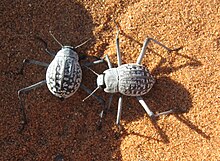Mist Drinker Beetle
| Mist Drinker Beetle | ||||||||||||
|---|---|---|---|---|---|---|---|---|---|---|---|---|

Onymacris unguicularis in the position to collect fluid |
||||||||||||
| Systematics | ||||||||||||
|
||||||||||||
| Scientific name | ||||||||||||
| Onymacris unguicularis | ||||||||||||
| ( Hague , 1875) |
The fog drinker beetle ( Onymacris unguicularis ) is a beetle from the family of the black beetle (Tenebrionidae). It is endemic to the Namib Desert .
features
The mist drinker beetle is black, about two centimeters tall and has noticeably long legs. The wing covers are like the pronotum almost completely smooth and shiny, furrowed back slightly only toward the rear end. The wing covers are fused at the seam, the hind wings receded. The space under the wing covers is transformed into a breathing chamber. The abdominal spiracles open into this space, which only comes into contact with the outside world via a gap at the rear end, which can be closed. Depending on the outside temperature, he has to renew his breath every 10 to 30 minutes. Since the dune sand is permeable to air, they don't necessarily have to go to the surface.
Way of life
Onymacris unguicularis is a species of open sand dunes. He lives in the loose, drifting sand of the dune ridges. When enemies approach that are visually perceived, it dives into the loose sand in a flash. The beetle is not only able to dig in loose sand, but also to swim through it. The species is diurnal, but evades in the hottest time in the morning and evening hours. He spends rest periods buried in the sand. For feeding, the beetle prefers the sheltered, sunny side of the dunes. It feeds on the scanty plant substances ( detritus ) that are blown in here . Its larvae have the same diet, but they rarely come to the sand surface.
Desert tenebrionids of the Adesmiini tribe are characteristic and species-rich for the desert regions of Namibia. Among the numerous species, however, only two of the genus Onymacris ( unguicularis and bicolor ) have the ability to use their own body surface to extract water from the clouds of fog that move from the Atlantic into the desert. To do this, the animals balance on a dune ridge with their heads down and stretch their rear ends up at an angle of around 20 degrees to the wind, similar to a headstand. Fine droplets of mist remain in the air and the collected water can be used. This ability is essentially a behavioral adjustment, not a morphological peculiarity. As tests with dead animals have shown, Onymacris unguicularis does not collect water more efficiently than related species without this behavior or tufts of grass. This way of life largely limits its distribution area to the western parts of the desert reached by the fog (see distribution map). However, the species is rarely found on dunes up to 45 kilometers inland.
During the mating season, the males attract the females by knocking their shell on hard ground, which attracts the females from several kilometers away. These knocking noises gave the beetle in Namibia the onomatopoeic name "Tok Tokkie".
Division of habitats

The different species of the genus Onymacris share different zones in the Namib:
- The mist-drinker beetle Onymacris unguicularis lives in the dune ridges
- Onymacris rugatipennis lives in the flat terrain in front of the dune foot
- Onymacris laeviceps lives in the vegetation at the foot of the dune
- The White Desert beetle Onymacris plana inhabits the Dünenfuß and is often at Narasträuchern found
Bionics
This principle of water collection was also copied by humans. Large nets with meshes were set up in Chile, for example, near the Atacama desert (see Atrapaniebla ). The mist gets stuck in the fine mesh, the water runs off and is collected in basins. A very simple and inexpensive way to obtain water, especially for developing countries. We are currently working on optimizing the networks. Similar to the beetle, the knob-like surface should also make it possible to collect fog water on roofs.
supporting documents
Individual evidence
- ↑ GN Louw, SW Nicholson, MK Seely Respiration beneath desert sand: carbon dioxide diffusion and respiratory patterns in a tenebrionide beetle. Journal of Experimental Biology 120: 443-447.
- ^ William J. Hamilton & Mark K. Seely (1976): Fog basking by the Namib Desert beetle, Onymacris unguicularis. Nature 262: 284-285 doi : 10.1038 / 262284a0
- ↑ Thomas Nørgaard & Marie Dacke (2010): Fog-basking behavior and water collection efficiency in Namib Desert Darkling beetles. Frontiers in Zoology 7:23. Open access
- ↑ Thomas Nørgaard, Martin Ebner, Marie Dacke (2012): Animal or Plant: Which Is the Better Fog Water Collector? PLoS ONE 7 (4): e34603. doi : 10.1371 / journal.pone.0034603 open access
- ↑ Distribution map
- ↑ http://www.umweltnetz-schweiz.ch/neuheiten/aktuelles/962-nebeltrinker-kaefer.html
literature
- Hubert Roer (1986): On the adaptation of the black beetle Onymacris unguicularis (Col., Tenebrionidae, Adesmiini) to the fog zone of the Namib desert. Bonn Zoological Contributions 37 (2): 143-154.
